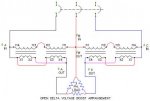philhanna@comcast.net
Member
I am new to the use of buck-boost transformers but after consulting the TEMCO selection chart and talking to their personnel, I selected 2- 1.5kva 120/240-16/32v isolation transformers to boost my 208v, 3 phase, 63kva, 93amp load to 222volt. I understand, in theory, that these transformers are not handling the entire load, but when I look at the connection diagram (#8 on the TEMCO website) I can see that phase B bypasses the transformers but phase A and phase C each connect to a transformer through two #12 wires. I have a hard time connecting my 93A load to these two #12 wires. Can anyone help me understand this and justify that connection?


